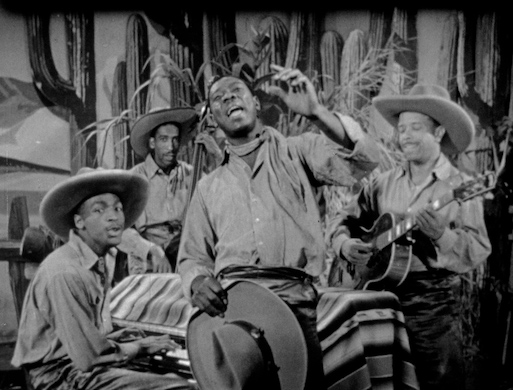Ever Heard of ‘Soundies’? This Collection Is a Necessity for American Popular Music Devotees
The mini-movies are ‘a little-known way-station in the long migration of the moving image to ever smaller screens.’ Tune in for performances by the Nat Cole Trio, Hoagy Carmichael, Duke Ellington, and many more.
Few items that have come through the transom in recent months have elicited as much joy, as much wonder and surprise, as “Soundies: The Ultimate Collection,” a four-disc Blu-Ray set released by Kino Lorber. For devotees of American popular music, the package is nothing short of a necessity, being a cornucopia of mid-century song and dance. Kino Lorber has, in other words, come bearing gifts — more than a few being rare, many exultant, and some a bit troublesome. More on that anon.
What, you might ask, is a Soundie? The ready answer is that they’re antecedents to music videos, and the device on which they were played, the Panoram, a kissing cousin to the jukebox. The author of “Soundies and the Changing Image of Black Americans On Screen; One Dime at a Time” and curator of the Kino Lorber set, Susan Delson, posits these mini-movies as “a little-known way-station in the long migration of the moving image to ever smaller screens.” Their hey-day was the years during World War II and their purview, inadvertent but inescapable, a changing America.
Close to two-dozen businesses were producing coin-operated video machines in 1940, but only one ultimately thrived. By 1942, the Chicago-based Mills Novelty Company was the last Panoram standing and its typical habitue was the back of the bar. The cost of playing a three-minute Soundie was a thin dime, but, as the New York Times reported, that made them “the highest-priced cinema entertainment,” considering most people would play several at a sitting. The typical movie ticket of the era was about a quarter. That, and Soundies didn’t come with a newsreel and a cartoon.
What they did come with was a staggering array of talent and a kaleidoscopic overview of the nation’s citizenry. “Stirring Up the Melting Pot” is the title of one section of “Soundies,” and I dare say the collection, as a whole, gives a truer overview of American culture than did Hollywood of the time. That a significant number of Soundies are devoted to country music, rhythm and blues, and the leggy charms of the female form — Army bases being another locale in which you’d find the Panoram — points to savvy entrepreneurs who took into account the specific market in which the video jukebox would be situated. It wouldn’t be the first time capitalist initiative would benefit artistic fact.

Take into account some of the figures peppering this sterling collection: the Nat Cole Trio, Merle Travis, Hoagy Carmichael, Duke Ellington, Louis Jordan and His Tympany Five, Stan Kenton, Fats Waller, Cab Calloway, Les Paul, Doris Day, Sister Rosetta Tharpe, and an up-and-coming pianist then known as Walter Liberace. Fans of the New York boroughs other than Manhattan will take note of a very young Ricardo Montalban making his screen debut as the titular heartthrob in “He’s a Latin from Staten Island.” “Soundies” captures them all in exuberant fettle.
Each section of “Soundies” comes with an introduction by Ms. Delson, often in tandem with the media conservationist at the National Museum of African American History and Culture, Ina Archer. They’re on hand to provide historical context, but even as they do the two scholars can’t resist engaging in identitarian cant. We’re cautioned, for instance, about “misplaced exoticism” and told, with a straight face, that the 1940s “were not a non-binary era.”
Race relations back in the day were fraught, cultural stereotypes commonplace, and let’s not forget the country was at war — all of which are reflected, to varying degrees of emphasis, in “Soundies.” We’re likely to roll our eyes at a toe-tapper like “We’ll Slap the Japs (Right into the Laps of the Nazis),” and not without reason, but history and its more tendentious artifacts should instill humility, not righteousness. The good news is that “Soundies,” for the most part, lets the content speak for itself.
There are innumerable finds in a set as varied as this one. A sleek Maurice Rocco clears the road for Little Richard, and Harry “The Hipster” Gibbon does much the same for Jerry Lee Lewis. Day, Dawn and Dusk, a trio of African-American singers adept at commingling high and low culture, weren’t only mellifluous vocalists but gifted comedians. Elsewhere, Dorothy Dandridge and Gale Storm are seen to glorious effect, strange drifts of Surrealism sneak into the proceedings, and a pop standard, “Along the Navajo Trail,” is done up more than right by the estimable John “Shadrach” Horace and Johnny Moore’s 3 Blazers.
What are you waiting for? “Soundies” is a valuable contribution to our understanding of 20th century America and an indicator of how pop culture may well be the most effective agent for fostering true diversity.

